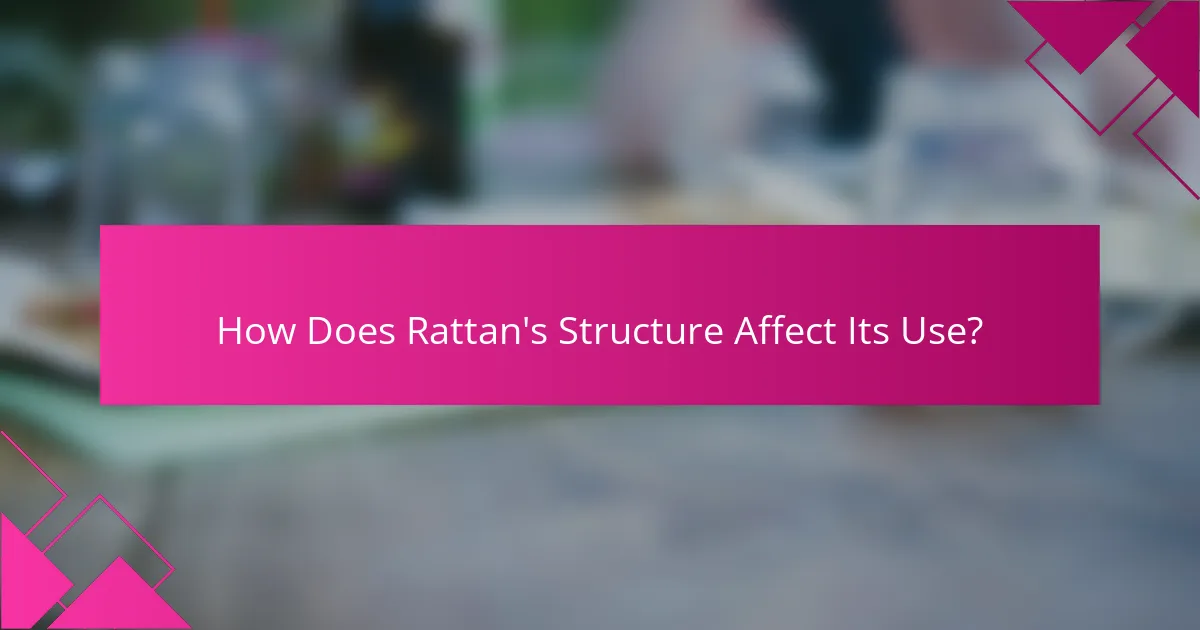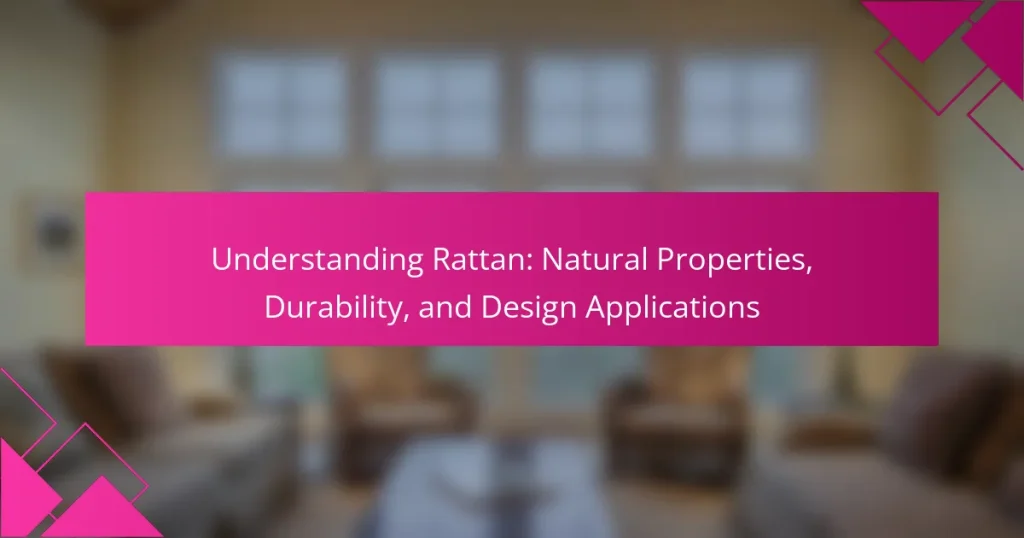Rattan is a climbing palm species recognized for its flexibility, strength, and sustainability, commonly found in tropical regions of Africa, Asia, and Australia. This material is integral to furniture and handicrafts, providing economic benefits to local communities due to its rapid growth and minimal environmental impact when harvested responsibly. The unique structural properties of rattan, including its lightweight nature and durability, make it ideal for both indoor and outdoor applications, enhancing aesthetic appeal through intricate designs. Proper maintenance, including regular cleaning and protection from direct sunlight, is essential to preserve rattan products, while sustainable sourcing practices are crucial for environmental conservation.

What is Rattan and Why is it Important?
Rattan is a climbing palm species known for its flexibility and strength. It is primarily found in tropical regions of Africa, Asia, and Australia. Rattan is important due to its sustainable nature; it grows rapidly and can be harvested without harming the ecosystem. The material is widely used in furniture and handicrafts, making it economically significant for local communities. Its durability allows for long-lasting products that withstand wear and tear. Rattan also has a unique aesthetic appeal, contributing to its popularity in interior design.
What are the natural properties of rattan?
Rattan is a flexible, durable climbing palm. It possesses high tensile strength, making it resistant to breakage. Rattan is lightweight, which facilitates easy handling and transportation. It has a natural moisture resistance, allowing it to withstand humid conditions. The surface of rattan is smooth and can be easily finished or stained. Rattan has a unique aesthetic appeal due to its natural color variations. It can be woven into intricate designs, enhancing its versatility in furniture and decor. These properties make rattan a favored material in the furniture industry.
How does rattan’s flexibility contribute to its uses?
Rattan’s flexibility allows it to be easily shaped and woven into various forms. This characteristic makes it ideal for furniture, baskets, and decorative items. The pliable nature of rattan enables artisans to create intricate designs without breaking the material. Additionally, its flexibility contributes to comfort in furniture, as it can bend slightly under weight. Rattan’s ability to return to its original shape enhances durability in everyday use. This resilience is supported by its natural composition, which includes a high tensile strength. Consequently, rattan is favored in both indoor and outdoor applications for its aesthetic and functional benefits.
What is the significance of rattan’s lightweight nature?
Rattan’s lightweight nature is significant because it enhances its usability in various applications. This property makes rattan furniture easy to move and rearrange. Lightweight materials reduce transportation costs and effort. Rattan is commonly used in crafting furniture due to this advantage. Its lightweight characteristic allows for intricate designs without compromising structural integrity. Additionally, the ease of handling rattan promotes its use in both indoor and outdoor settings. The lightweight nature contributes to the overall versatility of rattan in design applications.
Why is rattan considered a durable material?
Rattan is considered a durable material due to its unique structural properties. It possesses a high tensile strength, which allows it to withstand significant weight and pressure. Rattan’s flexibility enables it to bend without breaking, making it ideal for furniture and other applications. Additionally, rattan is resistant to wear and tear, contributing to its longevity. The outer skin of rattan is tough, providing protection against environmental elements. Studies indicate that rattan furniture can last for decades with proper care. This durability is further enhanced by its natural resistance to pests and decay. Overall, rattan’s combination of strength, flexibility, and resistance makes it a highly durable choice for various uses.
How does rattan compare to other natural materials in terms of durability?
Rattan is known for its high durability compared to other natural materials like bamboo and wicker. It possesses a unique structure that allows it to withstand wear and tear effectively. Rattan’s fibers are strong and flexible, making it resistant to cracking and breaking. In contrast, bamboo can be more susceptible to splitting under pressure. Additionally, rattan has a natural resistance to moisture, which helps prevent mold and decay. This quality gives it an advantage over materials like untreated wood, which can deteriorate in humid conditions. Overall, rattan’s durability makes it a preferred choice for furniture and decor items in various environments.
What factors influence the longevity of rattan products?
The longevity of rattan products is influenced by several key factors. First, the quality of the rattan itself plays a crucial role. High-quality rattan has a denser structure and is more resistant to wear. Second, the treatment processes used during manufacturing can enhance durability. Treatments such as drying and sealing protect against moisture and pests. Third, environmental conditions affect longevity. Rattan products exposed to excessive sunlight or humidity may degrade faster. Fourth, maintenance practices impact lifespan. Regular cleaning and proper storage can prevent damage. Lastly, usage patterns also determine durability. Products subjected to heavy use may wear out quicker than those used minimally.
What are the design applications of rattan?
Rattan is widely used in furniture design, especially for chairs and tables. Its lightweight yet durable nature makes it ideal for both indoor and outdoor settings. Rattan can be woven into intricate patterns, adding aesthetic appeal to various designs. It is also used in crafting decorative items like baskets and lampshades. The versatility of rattan allows for various finishes, from natural to painted. This adaptability makes it suitable for diverse interior styles, ranging from traditional to contemporary. Additionally, rattan is an eco-friendly material, appealing to sustainable design practices. Its use in design has been recognized globally, contributing to its popularity in modern home decor.
How is rattan used in furniture design?
Rattan is used in furniture design for its flexibility and durability. It can be woven into various shapes and forms, making it suitable for chairs, tables, and decorative pieces. Rattan furniture is lightweight, allowing for easy movement and rearrangement. The natural appearance of rattan adds warmth and texture to interiors. Its resistance to wear and tear makes it ideal for both indoor and outdoor use. Rattan is often combined with other materials like metal or glass for enhanced aesthetics. The sustainable nature of rattan appeals to eco-conscious consumers. Overall, rattan’s unique properties contribute to its popularity in contemporary furniture design.
What are some innovative uses of rattan in modern architecture?
Rattan is increasingly used in modern architecture for its versatility and sustainability. Architects utilize rattan for creating lightweight structures that are also durable. It is often employed in furniture design, providing aesthetic appeal and comfort. Rattan can be woven into intricate patterns for wall coverings, enhancing visual interest. Additionally, rattan is used in eco-friendly building materials, promoting sustainable practices. Its natural flexibility allows for innovative designs in both residential and commercial spaces. The material’s ability to withstand various weather conditions makes it suitable for outdoor applications. Overall, rattan’s unique properties contribute to contemporary architectural trends focused on sustainability and design.

How Does Rattan’s Structure Affect Its Use?
Rattan’s structure significantly affects its use due to its unique combination of flexibility and strength. The hollow stems of rattan allow it to bend without breaking, making it ideal for furniture design. This flexibility enables intricate weaving and shaping, which enhances aesthetic appeal. Additionally, rattan is lightweight, facilitating easy transport and handling. Its fibrous composition provides durability, allowing it to withstand wear and tear. Rattan’s natural resilience makes it suitable for both indoor and outdoor applications. The structure of rattan contributes to its popularity in sustainable design, as it is a renewable resource.
What are the unique attributes of rattan?
Rattan has several unique attributes. It is a climbing palm that grows in tropical regions. Rattan is known for its flexibility and strength. This allows it to be easily shaped into various furniture designs. It has a lightweight structure, making it easy to transport. Rattan also possesses a natural aesthetic appeal due to its distinctive texture. Additionally, it is durable and resistant to wear, making it suitable for long-term use. The material can be woven into intricate patterns, adding to its versatility in design. Rattan is also eco-friendly, as it is a renewable resource that grows quickly.
Why is the outer skin of rattan significant for its applications?
The outer skin of rattan is significant for its applications due to its durability and flexibility. This skin provides structural support, making it ideal for furniture and crafts. The skin’s natural resistance to wear enhances longevity in various products. Additionally, it can be easily dyed or treated for aesthetic purposes. Rattan’s outer layer is lightweight, facilitating easy handling and transport. Its unique texture adds visual appeal, making it popular in design. These attributes contribute to rattan’s versatility across multiple applications, from home decor to outdoor furnishings.
How do the internal fibers of rattan enhance its strength?
The internal fibers of rattan enhance its strength through their unique structural composition. These fibers are dense and tightly packed, providing significant tensile strength. The arrangement of the fibers allows rattan to resist bending and breaking under pressure. Additionally, the fibers contribute to the overall flexibility of rattan, enabling it to withstand impacts without damage. Research shows that the tensile strength of rattan can be comparable to that of steel in certain applications. This remarkable strength-to-weight ratio makes rattan a popular choice in furniture and design.
What are the environmental benefits of using rattan?
Rattan offers significant environmental benefits. It is a renewable resource that grows rapidly, making it sustainable. Rattan can sequester carbon dioxide effectively, contributing to climate change mitigation. Its cultivation supports biodiversity by providing habitats for various species. Using rattan reduces the need for timber, helping to conserve forests. Rattan products often require less energy to produce compared to synthetic materials. This leads to lower carbon emissions during manufacturing. Additionally, rattan can be harvested without killing the plant, ensuring ongoing growth and resource availability.
How does rattan cultivation impact local ecosystems?
Rattan cultivation significantly impacts local ecosystems. It can lead to habitat loss for native species. Deforestation for rattan plantations reduces biodiversity. Soil erosion may increase due to the removal of natural vegetation. In some cases, rattan cultivation can promote sustainable land use. It provides an alternative income for local communities. Sustainable practices can enhance ecosystem services. Research indicates that well-managed rattan systems can support wildlife.
What makes rattan a sustainable choice for consumers?
Rattan is a sustainable choice for consumers due to its rapid growth and renewability. It can grow up to 10 centimeters per day in tropical climates. Rattan is a vine, which means it can be harvested without cutting down the entire plant. This harvesting method allows the plant to continue growing and producing new shoots. Additionally, rattan is often sourced from forests that are managed sustainably. This practice helps preserve biodiversity and supports local economies. Rattan products are also biodegradable, reducing environmental impact at the end of their lifecycle. Overall, these characteristics contribute to rattan’s reputation as an eco-friendly material.

What Considerations Should Be Made When Using Rattan?
Considerations when using rattan include its durability, maintenance requirements, and environmental impact. Rattan is a strong and flexible material, making it suitable for furniture and decor. However, it requires proper care to prevent wear and tear. Regular cleaning with a damp cloth is essential to maintain its appearance. Additionally, rattan should be kept away from direct sunlight to avoid fading and drying out. The environmental impact of sourcing rattan also matters. Sustainable harvesting practices are crucial to preserve natural habitats. Choosing certified rattan products can ensure responsible sourcing.
How should rattan furniture be maintained?
Rattan furniture should be maintained by regularly cleaning it with a soft, damp cloth. This removes dust and debris without damaging the surface. Additionally, applying a mild soap solution can help to eliminate stains. It is important to avoid harsh chemicals that can degrade the rattan. Rattan should be kept in a dry environment to prevent mold and mildew growth. Periodically check for loose strands and tighten them if necessary. To maintain its appearance, consider applying a protective sealant designed for rattan. This can enhance durability and resistance to moisture. Regular maintenance extends the lifespan of rattan furniture significantly.
What cleaning methods are best for preserving rattan’s quality?
The best cleaning methods for preserving rattan’s quality include gentle dusting, mild soap solutions, and avoiding excessive moisture. Dusting rattan furniture weekly with a soft cloth prevents dirt buildup. For deeper cleaning, a mixture of warm water and mild soap can be applied with a soft sponge. It is crucial to avoid soaking rattan, as excessive moisture can cause warping. After cleaning, the rattan should be dried immediately with a dry cloth. Regular maintenance helps maintain its appearance and durability. These methods are recommended by experts in furniture care to ensure longevity.
How can rattan products be protected from environmental damage?
Rattan products can be protected from environmental damage by applying protective coatings. These coatings create a barrier against moisture and UV rays. Regular cleaning with a soft cloth prevents dirt accumulation. Storing rattan items indoors during harsh weather reduces exposure to elements. Using breathable covers can also shield rattan from dust and humidity. Additionally, maintaining a consistent humidity level in storage areas is beneficial. These measures prolong the lifespan of rattan products. Research indicates that proper care can enhance durability significantly.
What are the common misconceptions about rattan?
Rattan is often misunderstood as being the same as bamboo. While both are used in furniture, rattan is a vine and bamboo is a grass. Another misconception is that rattan furniture is not durable. In reality, rattan is known for its strength and longevity when properly cared for. Many believe rattan is only suitable for outdoor use. However, it can also be effectively used indoors, adding elegance to various designs. Some think rattan requires extensive maintenance. In fact, rattan is relatively low-maintenance, needing only occasional cleaning. Lastly, there is a belief that all rattan is synthetic. Most rattan furniture is made from natural materials, contributing to its eco-friendliness.
Why is rattan sometimes mistaken for synthetic materials?
Rattan is sometimes mistaken for synthetic materials due to its smooth texture and uniform appearance. These characteristics can resemble those of plastic or resin products. Additionally, rattan can be treated or finished in ways that enhance its durability and aesthetic appeal. Such treatments may further blur the line between natural and synthetic materials. The similarity in color and sheen can lead to confusion among consumers. Furthermore, the lightweight nature of rattan can also be associated with synthetic alternatives. These factors contribute to the frequent misidentification of rattan as a synthetic material.
What are the myths surrounding the durability of rattan?
Rattan is often believed to be fragile and easily breakable, which is a myth. In reality, rattan is known for its strength and flexibility. It can withstand significant pressure without breaking. Another common myth is that rattan furniture cannot endure outdoor conditions. However, rattan is naturally resistant to weather elements when treated properly. Some people think rattan requires excessive maintenance. In fact, it only needs occasional cleaning and care to maintain its durability. Additionally, rattan is sometimes viewed as less durable than wood. Studies show that with proper treatment, rattan can last just as long as hardwoods. These myths contribute to misconceptions about rattan’s true durability and utility in design applications.
What tips can help consumers make informed choices about rattan products?
To make informed choices about rattan products, consumers should consider several key factors. First, examine the quality of the rattan. High-quality rattan is flexible, strong, and free from cracks. Next, check the craftsmanship. Well-made products feature tight weaves and sturdy construction. Additionally, assess the finish. A good finish protects the rattan and enhances its appearance.
Consumers should also inquire about sourcing. Ethically sourced rattan supports sustainable practices. Furthermore, understand the maintenance requirements. Rattan products may need regular cleaning and conditioning to maintain their integrity. Lastly, compare prices among similar products. This helps ensure that consumers receive fair value for their investment.
Rattan is a climbing palm species known for its flexibility, strength, and sustainable nature, primarily found in tropical regions. This article explores rattan’s natural properties, including its high tensile strength, lightweight structure, and moisture resistance, which contribute to its durability and versatility in furniture and design applications. Additionally, it discusses the environmental benefits of rattan, its significance in local economies, and common misconceptions regarding its durability and maintenance. The article also provides insights into proper care for rattan products and innovative uses in modern architecture, emphasizing its role as an eco-friendly material in contemporary design.


